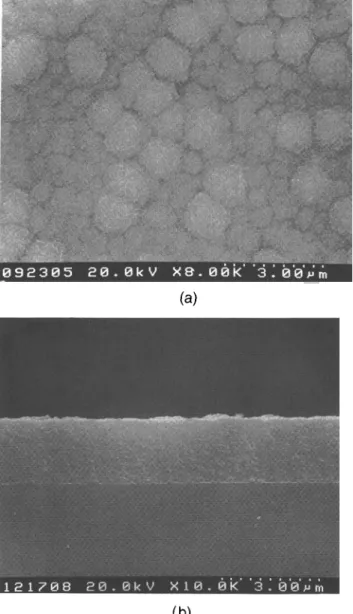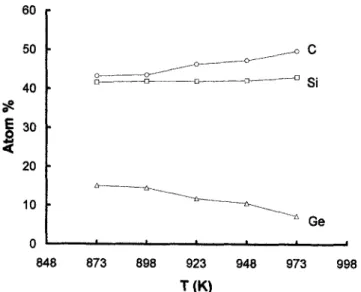http://journals.cambridge.org Downloaded: 28 Apr 2014 IP address: 140.113.38.11
Growth of ternary Sii-jc-jGe
xCy thin films
from a single-source precursor, Ge(SiMe3)4
Hsin-Tien Chiu, Ching-Shing Shie, and Shiow-Huey ChuangDepartment of Applied Chemistry, National Chiao Tung University, Hsinchu, Taiwan 30050, Republic of China
(Received 17 March 1994; accepted 18 December 1994)
Ge(SiMe3)4 was used as a single-source precursor to deposit thin films of alloys
of germanium, silicon, and carbon, Sii-^-^Ge^Cj,, by low-pressure chemical vapor deposition on silicon substrates at temperatures 873-973 K. X-ray diffraction studies indicated that the films grown above 898 K were cubic phase {a = 0.441-0.442 nm). Infrared spectra of the films showed a major absorption near 783 cm"1. X-ray
photoelectron spectra of a typical thin film showed binding energies of Ge3d, Si2p, and Cis electrons at 30.0, 100.6, and 283.2 eV, respectively. As determined by wavelength dispersive spectroscopy, x was 0.07-0.15 and y was 0.43-0.50, indicating that the films contained 7 - 1 5 % Ge, 3 8 - 4 3 % Si, and 43-50% C. At 973 K, the C/(Si + Ge) ratio was 1. Based on these data, the films deposited above 898 K have a structure of /3-SiC with Ge atoms replacing some Si atoms in the lattice.
In a recent report, Soref showed that in theory, the indirect band gaps of ternary semiconductor materials Sii-x-yGexCy can span a wide range of 0.62-5.5 eV
by adjusting the variables x and y} This makes the alloys potentially useful for many applications. Thin films of Si\-x-yG&xCy can be grown by molecular beam epitaxy (MBE) and chemical vapor deposition (CVD).23
Based on our previous experience of depositing /3-SiC thin films from single-source precursors, employing organopolysilanes of small molar mass as the sources for both silicon and carbon atoms, we think that the alloy films can be grown from molecules containing Ge, Si, and C atoms.4"6 In this communication, we report our
preliminary investigations on the use of an organometal-lic compound, Ge(SiMe3)4, as a single-source precursor
to grow S\\-x-yG&xCy thin films by CVD.
Ge(SiMe3)4 was synthesized according to a literature
route.7 After Si substrates in a low-pressure hot-wall
CVD reactor were etched by hydrogen plasma to in-crease nucleation sites, the solid precursor was sublimed at 313 K to start deposition.6 Deposition of thin films
on silicon substrates was performed at 873-973 K and 1 Pa (no carrier gas) and 70 Pa (flow of H2 at 20 seem).
Soft, grey to brown, and mirror-like thin films with good adhesion to the substrates (Scotch Tape test) were obtained. The surface morphology was smooth with very fine grains as shown by the scanning electron micrograph (SEM) in Fig. l(a). Growth rates, estimated from the crosssectional SEM micrographs [Fig. l(b)], were 4
-13 nm min"1.
The x-ray diffraction (XRD) pattern of a typical thin film grown at 978 K is shown in Fig. 2 It shows major CuKa peaks at angles 20 equal to 35.12°, 40.82°, 59.51°,
and 70.79° for the film. These peaks are characteristic of (111), (200), (220), and (311) reflections of a cubic structure with a lattice parameter a = 0.4417 nm. The data are close to the values of /3-SiC, 35.59°, 41.38°, 59.98°, and 71.77° for the reflections, and 0.435.8 nm for the lattice parameter.8 Films deposited at 878 K
were amorphous as indicated by their XRD patterns. Infrared spectra of the films showed a strong absorption near 783 cm"1, which is near but shifted a little from
the characteristic S i - C stretching frequency (^sic) of /3-SiC at 800 cm"1.9 No other absorption bands were
clearly observed.
Analyses by the following methods confirm that Ge, Si, and C atoms were in the films. High resolution x-ray photoelectron spectra (XPS) of a typical sample deposited at 898 K showed binding energies of the following electrons, Ge3d (30.0 eV), Si2p (100.6 eV), Ci, (283.2 eV), and Ois (532.0 eV), after some of
the contaminated surface layers were removed by Ar+
sputtering. The binding energies of the Si2p and Cl s
peaks are close to the values known for /3-SiC, while the Ois peak is assignable to Si-bonded O atoms.4'5 The
Ge3<? signal indicates that the Ge atoms were neither
condensed into their elemental form, which is at 29 eV, nor connected to hydrocarbon fragments alone, which is at 31 eV.1011 Thus, it is more likely that the Ge atoms
were mixed homogeneously with the Si and C atoms. Auger depth profiling showed uniform distributions of Si, Ge, and C atoms within the films. Oxygen concen-tration was low except at the surface. The films were analyzed by wavelength dispersive spectroscopy (WDS) to determine their bulk compositions. The results are plotted against the temperature of deposition and shown
http://journals.cambridge.org Downloaded: 28 Apr 2014 IP address: 140.113.38.11 H-T. Chiu et al.: Growth of ternary thin films
. • • - . . " . : •
<"•-•%.
26 (degree)
FIG. 2. XRD pattern of a thin film deposited at 973 K.
8 9 5 3 8 5 8 0 . 0 k V X 8 . 0 0 k' "3 '. 0 0 V ,
(a)
FIG. 1. SEM photographs of thin films, (a) Surface, deposited at 973 K without carrier gas; (b) Cross section, deposited at 923 K H2 20 seem.
in Figs. 3 and 4. For the films deposited without carrier gas (Fig. 3), C concentrations were relatively constant at 46-50%, while Si concentrations increased slightly from 38% to 43% and Ge concentrations decreased from 13% to 7% with increasing temperature of deposition from 873 to 973 K. For the films grown under hydrogen (Fig. 4), Si concentrations were relatively constant at 42-43%, while C concentrations increased from 43% to 50% and Ge concentrations decreased from 15% to 7% with increasing temperature of deposition. In Fig. 5, C/(Ge + Si) ratios are plotted against the temperature of deposition between 873 and 973 K. For the films grown without carrier gas, the ratios span a narrower range of 0.85-1.00 while the ratios for those deposited under hydrogen increase with increasing temperature of deposition from 0.76 to 1.00. However, the difference
35 60 r 50 40 30 20 10 Ge 848 873 898 923 948 973 998
T(K)
FIG. 3. Effect of temperature of deposition on elemental concentra-tions of the films deposited without carrier gas.
is not significant enough to draw a conclusion on the effect of hydrogen at this stage. In general, the films grown at high temperatures and without carrier gas have the C/(Ge + Si) ratios close to 1.
Based on the data discussed above, we suggest that the films have a thermodynamically favored /3-SiC lattice with some Si atoms replaced by larger Ge atoms. Therefore, the films showed a larger and ^Sic
smaller than those of /3-SiC. It is interesting to note that the temperatures employed to deposit thin films in this study, 873-973 K, are much lower than the conditions required to deposit crystalline /3-SiC thin films from organopolysilanes, above 1273 K.4"6 This
is probably due to a difference in bond strengths
between the Ge-Si bonds of Ge(SiMe3)4 and the
Si-Si bonds of other organopolysilanes. In general, the strengths of M-X bonds (M: group IVA elements; X: other elements) decrease from Si to Pb.12 As a
result, precursors containing Ge start to decompose at temperatures lower than the decomposition temperatures of analogous Si-containing precursors. For example,
http://journals.cambridge.org Downloaded: 28 Apr 2014 IP address: 140.113.38.11 H-T. Chiu et al.: Growth of ternary thin films
60 50 40 30 20 10 0 848 873 898 923 948
T(K)
973 998FIG. 4. Effect of temperature of deposition on elemental concentra-tions of the films deposited under hydrogen.
1.40 1.20 * 1.00 $ ^T 0.80
o
0.60 0.40 848 873 898 923T(K)
948 973 998FIG. 5. Effect of temperature of deposition on C/(Ge + Si) ratio of the films (D) no carrier gas; (O) H2 20 seem.
SiEt4 decomposes at 1073 K while GeEt4 decomposes at 773 K to deposit thin films, a parallel example.13-14 Preliminary analyses of the volatile products by a residual gas analyzer (RGA) showed the evolution of hydrogen, methane, trimethylsilane, tetramethylsilane, and tetramethylgermane in the process. It is also interesting to note that Ge/Si ratios of the films grown in this study decreased from 0.36 to 0.16
with increasing temperature of deposition, while the precursor has a Ge/Si ratio of 0.25. Formation of tetra-methylgermeane in the process can be employed as a reason to account for the partial lowering of Ge concentration at high temperatures of deposition. It is not surprising to observe that the films were rich in C since the precursor contains many methyl groups.
In conclusion, we have shown that organometallic compound Ge(SiMe3)4 can be employed as a
single-source precursor to grow Sii-^-^Ge^Cy thin films (x = 0.07-0.15, y = 0.43-0.50) by CVD. As suggested by this study, it is possible to use organometallic compounds containing different numbers of Si, Ge, and C atoms as single-source precursors to adjust the composition of Sii-.t-yGe^Cy thin films grown by CVD. Studies related to this report are in progress.
ACKNOWLEDGMENTS
We thank the National Science Council of Taiwan, Republic of China (NSC-83-0208-M-009-033) for support and the Instrument Center of the NSC for sample analyses.
REFERENCES
1. R.A. Soref, J. Appl. Phys. 70, 2470 (1991).
2. K. Eberl, S.S. Iyer, S. Zollner, J.C. Tsang, and F.K. LeGoues, Appl. Phys. Lett. 60, 3033 (1992).
3. J. L. Regolini, F. Gisbert, G. Dolino, and P. Boucaud, Mater. Lett. 18, 57 (1993).
4. H-T. Chiu, P-F. Wu, and J. Chin, Chem. Soc. 38, 231 (1991). 5. H-T. Chiu and S-F. Lee, J. Mater. Sci. Lett. 10, 1323 (1991). 6. H-T. Chiu and S-C. Huang, J. Mater. Sci. Lett. 12, 537 (1993). 7. A G. Brook, F. Abdesaken, and H. Sollradl, J. Organomett. Chem.
299, 9 (1986).
8. Joint Committee for Powder Diffraction Standards, Powder Diffraction File, File No. 29-1129 (JCPDS International Center for Diffraction Data, Swarthmore, PA, 1982).
9. W. R. Schmidt, L. V. Interrante, R. H. Doremas, T. K. Trout, P. S. Marchetti, and G. E. Maciel, Chem. Mater. 3, 257 (1991). 10. G. Hollinger, P. Kumurdjian, J.M. Mackowski, P. Pertosa,
L. Porte, and T.M. Due, J. Elect. Spectrosc. 5, 237 (1974). 11. S. Hoste, H. Willeman, D. Van der Vondel, and G.P.
Van der Kelen, J. Elect. Spectrosc. 5, 227 (1974).
12. F. A. Cotton and G. Wilkinson, Advanced Inorganic Chemistry, 5th ed. (John Wiley, New York, 1988), p. 265.
13. F. Maury, A. Mestari, and R. Morancho, Mater. Sci. Eng. A109, 69 (1989).
14. R. Carles, A. Mlayah, M. Amjoud, A. Reynes, and R. Morancho, Jpn. J. Appl. Phys. 31, 3511 (1992).

